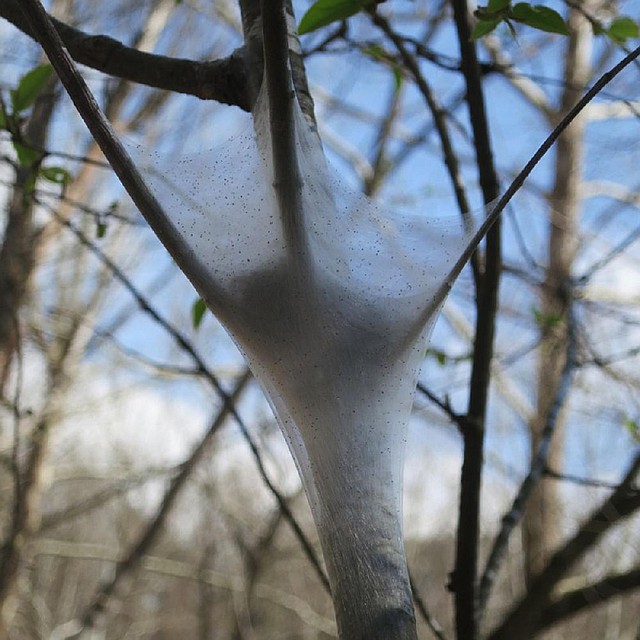Breaking ground
Eastern tent caterpillars build webs or “tents” in the spring in the forks of trees where they sleep at night and emerge in the day to eat.
Saturday, May 4, 2013
This year could go down in the record books as a year with no spring. Every time we think winter is over, we get another blast. Some parts of the state have had late frosts, and some early-planted, tender plants have been zapped.
Even in areas without a late frost, tomatoes, peppers or eggplants that were planted early could be shell-shocked from the lower than normal temperatures. If warm weather ever settles in, assess your plants after two weeks. If they appear to be prospering with a lot of new growth, then don’t worry but if they are just sitting there looking green, I would suggest replanting.
Spring bulbs lasted longer than normal, and the pansies and violas are still looking fabulous.
Continue to enjoy them, but by late May - at the latest - start to replace them with summer annuals. If you wait too late to start planting summer color, rising temperatures will make watering to get them established more of a challenge.
By now, most plants normally would have leafed out, and so you could assess winter damage.
But since it has been so cold, wait another couple of weeks before you start pruning dead-looking limbs - just to be certain.
I have had reports from some northern counties that new foliage appeared on some plants and then was killed by frost. Those plants need a little extra time to replace foliage.
If all your new growth is from the base of the plants, you will have to retrain them into new bushes or trees.
Farmers markets are opening all over the state. From lettuce to greens, onions and broccoli, we have vegetables. The strawberries are also ripening, albeit a little slowly, but we do have fresh fruit.
I have already had two reports of tick fever from gardeners. If you are out in the woods, monitor for tick activity.
The sooner you can prune spring-flowering shrubs after they finish blooming, the quicker they can recover and set buds for next year. Encore azaleas, along with other shrubs that re-bloom in the fall, should be pruned (if needed) after their spring flowers fade. Don’t prune them in late summer or fall. Fertilize all spring-blooming shrubs once after flowering, and that should suffice for the year.
I recommend pruning forsythia every year. Cut out one third of the older canes at the soil line.
Visit your area’s nurseries often. Many great plants arrive daily. I have seen a few I would not recommend - red top photenias are plagued with leaf spotting diseases; Colorado blue spruce prefers Colorado to Arkansas; and golden euonymus will entice scale insects to visit your yard.
If planting a tree, try something other than a Bradford pear. Don’t get stuck in a rut and plant the same tree as everyone else, especially one with known problems, like these pears.
MAY LESSON
Webs are appearing in many small trees around Arkansas. For a few weeks we will have the marching of the Eastern tent caterpillars. They look much worse than they really are, but they are a nuisance and can make a mess.
The larvae gather at a fork in the tree and build a web or “tent.” They use the tent as their nightly lodging, emerging on nonrainy days to feed. The tent enlarges as the caterpillars eat. If you can reach the tents, pull them down on a cloudy day or at dusk when the caterpillars have gathered for the night, and destroy them.
Luckily for us, the caterpillars have a short life span and don’t create more than one generation a year, unlike their cousin, the fall webworms, which will start appearing in a month or so and can have several generations each season.
Fall webworms build large, protective webs that usually start toward the ends of branches, and they feed within the nest. Nests increase in size as caterpillars feed. They do not leave the nests until they are ready to pupate.
Heavily infested trees can be completely covered with nests up to 3 feet long that enclose ends of branches. Large trees can endure the loss of leaves and recover, but the webs are unsightly. Young trees can be damaged with a heavy infestation.
As with the spring webs, if you can reach the webs, pull them out and destroy them. Don’t try burning them in the tree, an old-fashioned method of control. You might kill the worms, but you will also damage the tree - or yourself.
While many gardeners call the tent caterpillar and webworm a “bagworm,” the true bagworm feeds on junipers, cedars and the like. It normally begins its attack mid-May through mid-June.
As it feeds on the host plant, it constructs a protective sack around itself made of the plant it is feeding on, a great camouflage. If you have had bagworms on your ornamentals in the past, scout the plants for damage. Insecticides can control these pests, but the chemicals must be applied before the bags are fully formed. Unlike the tent- or web-forming caterpillars, bagworms can do major damage to our ornamental shrubs.
HomeStyle, Pages 33 on 05/04/2013
